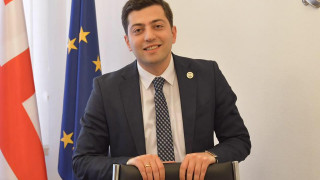Resume: We can analyse the implementation of infrastructure projects based on the budget execution figures of the Ministry of Regional Development and Infrastructure.
The 2020 budget of the Ministry of Regional Development and Infrastructure is GEL 2.071 billion. The Ministry’s first quarter plan for 2020 was GEL 408.078 million whilst the execution figure was GEL 433.9 million. Therefore, the Ministry’s first quarter plan was executed by 106.3%. In addition, almost all plans of the programs carried out by the Ministry ended in surplus. The first quarter plan of a large infrastructure project – certain sections of the high-speed highway – was also executed by nearly 100%. However, Zaza Gabunia made his statement on 22 April 2020 at the plenary session of the Parliament of Georgia and April data will be reflected in the second quarter figures. Moreover, the state of emergency was declared in Georgia on 21 March 2020 and the impact of the pandemic on project implementation will also become clearer in the second quarter of 2020. Given all of the aforementioned factors, FactCheck leaves the statement without a verdict.
Analysis
The Chairperson of the Regional Policy and Local Self-Governance Committee of the Parliament of Georgia, Zaza Gabunia, stated at the plenary session of the Parliament of Georgia: “None of the large infrastructure projects have been stopped.”
We can analyse the implementation of infrastructure projects based on the budget execution figures of the Ministry of Regional Development and Infrastructure.
The 2020 budget of the Ministry of Regional Development and Infrastructure is GEL 2.071 billion. The Ministry’s first quarter plan for 2020 was GEL 408.078 million (the budget is planned by quarters which means that only the first quarter budget’s execution figures are currently available) whilst the execution figure was GEL 433.9 million. Therefore, the Ministry’s first quarter plan was executed by 106.3%.
Table 1: Separate Infrastructure Programme Budget Execution Figures in the First Quarter of 2020
|
Programme |
Plan |
Fact |
Execution (%) |
|
Improvement of Road Infrastructure |
295.452 |
302.206 |
102.3 |
|
High-Speed Highway |
217.92 |
224.931 |
103.2 |
|
Restoration of Water Infrastructure |
45.454 |
61.308 |
134.8 |
|
Restoration of Regional and Municipal Infrastructure |
41.428 |
44.668 |
107.8 |
|
Solid Waste Management |
7.917 |
8.01 |
101.2 |
|
Support of Internally Displaced Persons |
5.301 |
5.301 |
100 |
|
Rehabilitation of General Education Infrastructure |
11.005 |
10.966 |
99.6 |
Source: State Treasury
According to the official data, almost all of the plans of the programs carried out by the Ministry of Regional Development and Infrastructure ended in surplus. The only exception is the rehabilitation of the general education infrastructure programme where execution slightly lags behind.
The first quarter budget execution figures of investment projects carried out by 2020 state budget donors; in particular, for certain sections of the high-speed highway were as follows:
|
Section |
Plan |
Fact |
Execution (%) |
|
Agara-Zemo Osiauri |
284,000 |
281,000 |
98.9 |
|
Zemo Osiauri-Rikoti |
12.590 million |
12.579 million |
99.9 |
|
Samtredia-Grigoleti |
17.775 million |
17.737 million |
99.8 |
|
Batumi’s new bypass road |
16.857 million |
21.660 million |
128.5 |
|
Chumateleti-Khevi |
1.454 million |
1.437 million |
98.8 |
|
Khevi-Ubisa |
23.630 million |
23.613 million |
99.9 |
|
Ubisa-Shorapani |
18.100 million |
18.087 million |
99.9 |
|
Shorapani-Argveta |
87.805 million |
90.227 million |
102.8 |
|
Zestaponi-Kutaisi-Samtredia |
4.262 million |
4.236 million |
99.4 |
|
Kobuleti’s new bypass road |
2.180 million |
2.102 million |
96.4 |
Source: State Treasury
As illustrated by the figures, there are full budget executions in almost all ongoing sections of the high-speed highway and there are also surplus executions for two sections.
However, in order to analyse the continuity of the implementation of infrastructure projects by the end of April (the statement was made on 22 April 2020 at the plenary session of the Parliament of Georgia), it would be appropriate to wait for the second quarter execution figures. Of additional note is that on 21 March 2020 Georgia declared a state of emergency because of the coronavirus pandemic. The state of emergency did not impose restrictions on infrastructure projects and companies were allowed to carry out work in compliance with safety rules and the recommendations issued by the Georgian Ministry of Healthcare. Although, restrictions were imposed on the production of building materials, these restrictions were lifted on 5 May 2020. The lifting of the restrictions does not apply to the trade of building materials and only online purchase is allowed. The experience of the past years when the implementation of large infrastructure projects (in particular, the construction of certain sections of the high-speed highway) were hampered and project deadlines were often not met (see: article 1, article 2) also needs to be taken into account. Given all of the aforementioned, we will be able to see the clear picture of how infrastructure projects were carried out during the pandemic in the second quarter of 2020. FactCheck will continue to keep an eye on the implementation of infrastructure projects and provide our readers with updated information.








